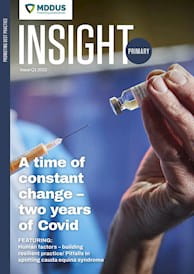BACKGROUND
A 42-year-old project manager, Mr U, makes an urgent appointment at his GP surgery. He is suffering with lower back pain which he thinks was triggered by some heavy gardening a couple of weeks previously.
Dr S examines the patient and records: Low back pain – two weeks, gardening/No bladder/bowel signs/No weakness/numbness of legs/Dx muscular/Prescribed analgesia/Consider physio if no improvement.
Two months later Mr U returns to the surgery. He reports that his symptoms eased initially but have now returned and grown more intense in the last few days – with right lower back pain extending down to the knee. Mr U also reports a "tingling sensation" in his upper thigh.
Examination by Dr S reveals a positive right SLR (straight leg raise) of 50 degrees and normal left leg. Power, sensation and reflexes are all intact. Rectal examination reveals no altered sensation and Mr U is able to bear down.
Dr S records a diagnosis of likely sciatica, secondary to disc herniation. Mr U is prescribed analgesia (Naproxen) and advised to rest. The records state: Advised regarding red flag symptoms/return if no improvement. Refer then for MRI/further management.
Three weeks later Mr U is urged by his wife to phone the surgery. A telephone consultation with Dr S is scheduled for later that day. The patient reports that his leg pain has improved but he is now experiencing numbness in his groin. Dr S records: Back/leg pain improved/Numbness in groin/ Passing water and stool. An urgent face-to-face appointment is arranged.
Mr U reports that his leg pain has responded well to the analgesia but he is concerned by numbness in his groin region. Dr S undertakes an examination and records: Leg pain less/obvious numbness in groin. No incontinence urine/stool. Constipation/opening bowels difficult. SLR 80 degrees, right ankle reflex lost. Anal wink lost/reduced sensation, anal contraction poor.
An urgent referral is arranged and an MRI reveals a large L5/S1 disc prolapse compromising the cauda equina. Mr U undergoes decompression surgery and makes a good recovery but with some persisting altered sensation in the right leg and groin, constipation, mild difficulty emptying his bladder but no incontinence.
A solicitor's letter is later sent to Dr S claiming negligence in the clinical care of Mr U. The letter alleges that the GP failed to adequately assess red flag symptoms of cauda equina and refer Mr U for emergency assessment by a specialist.
The letter claims that had Mr U been referred to hospital after the first follow-up consultation he would have likely undergone an emergency MRI scan which would have identified a paracentral disc protrusion compressing the cauda equina. Emergency decompression and discectomy surgery then would have likely led to a complete recovery. It is alleged that due to the delayed diagnosis, Mr U suffered a prolonged period of pain prior to his operation in addition to ongoing symptoms of numbness and mobility problems.
ANALYSIS/OUTCOME
MDDUS acting on behalf of Dr S reviews the case file and commissions reports from an independent GP expert and a consultant neurologist.
Considering the notes, the GP expert opines that findings from the first follow-up consultation suggest a diagnosis of unilateral sciatica. She comments that a “tingling sensation” in the upper thigh would not normally be associated with cauda equina. Numbness or reduced urinary function would be hallmarks.
The GP expert concludes that the records attest to a proper assessment of back pain and a reasonable diagnosis of sciatica, with management and follow-up advice.
The GP expert further opines that urgent referral after the second follow-up telephone and then face-to-face consultation (given the reported groin numbness) was certainly warranted.
The neurologist is asked to comment on causation (consequences of any breach of duty of care). He concludes that had Mr U been referred to A&E after the first follow-up consultation, given his presentation on the day, there would have been no indication for emergency MRI and the patient would have likely been discharged back to his GP for follow-up and advice.
MDDUS lawyers respond to the allegations citing the expert reports and the claimant solicitors later confirm the case has been discontinued.
KEY POINTS
- Ensure clinical observations and safety netting advice are adequately recorded in the patient notes.
- Most back pain is musculoskeletal in origin but it essential to be alert to other causes.
This page was correct at the time of publication. Any guidance is intended as general guidance for members only. If you are a member and need specific advice relating to your own circumstances, please contact one of our advisers.
Read more from this issue of Insight Primary

Save this article
Save this article to a list of favourite articles which members can access in their account.
Save to library



